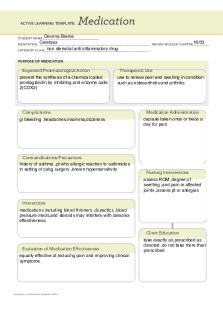Med Template Chlorpromazine PDF

| Title | Med Template Chlorpromazine |
|---|---|
| Author | Heather Morales |
| Course | ati templates |
| Institution | Lincoln Technical Institute |
| Pages | 1 |
| File Size | 61.3 KB |
| File Type | |
| Total Downloads | 74 |
| Total Views | 129 |
Summary
ati templats...
Description
ACTIVE LEARNING TEMPLATE:
Medication
Heather Morales STUDENT NAME _____________________________________ Chlorpromazine
(Droperidol, Fluphenazine, Fluphenthixol, Haloperidol)
MEDICATION __________________________________________________________________________
REVIEW MODULE CHAPTER ___________
Conventional Antipsychotics (Pericyazine, Pimozide, Thioridazine, Thiothixen) CATEGORY CLASS ______________________________________________________________________
PURPOSE OF MEDICATION
Expected Pharmacological Action - Blockade of dopamine 2 receptors (D2) is responsible for reducing the positive signs of pyschosis & improving other behaviors - The combined effect to block D2, histamine H1 & muscarinic M1 receptors in the vomiting center is postulated to reduce N/V
Therapeutic Use - Suppresses symptoms of schizophrenia - Acute manic phase of bipolar disorder - Relieves nausea/vomiting - Intractable hiccups Droperidol, Fluphenazine, Fluphenthixol,Haloperidol, Pericyazine, Pimozide, Thioridazine, Thiothixene
Complications - Akathisia – occurs within first 2 months of therapy - Parkinson-like symptoms may occur within first month of therapy - Acute dystonia – occurs hours to days following first dose - Tardive dyskinesia – occurs months to years after therapy begins - Anticholinergic effects – dry mouth, constipation, urinary retention, blurred vision, tachycardia - Suppressed sexual drive, erectile dysfunction - Severe dysrhythmias - Dermatitis, photosensitivity when exposed to sunlight Neuroleptic malignant syndrome (NMS) – high fever, rigidity, VS instability, loss of consciousness (more common with haloperidol and other high-potency drugs than chlorpromazine)
Medication Administration - Give oral dose with food and/or full glass of water to prevent GI effects - Have client swallow SR form whole - Give IM injection in large muscle; rotate sites - Keep client recumbent for 30 minutes after IM or IV dose due to possi- ble hypotension - IV form incompatible in solution w/ mult drugs - Give IV bolus no faster than 1 mg/minute
Contraindications/Precautions *CONTRAINDICATED - Allergy to phenothiazine anti psychotic drugs - Alcohol withdrawal - Bone marrow suppression - CNS depression - Pregnancy and lactation *PRECAUTIONS - Resp Disease - Glaucoma - Diabetes mellitus - Hypertension - Prostatic hypertrophy - Thyroid - Cardiac - Liver Disorders
Interactions - CNS depressants increase sedation - Antacids and Antidiarrheals – space 2 hours from chlorpromazine admin r/t poor absorption - Decreased blood level of antiseizure drugs
Nursing Interventions - Treat with beta blocker or benzodiazepine - Possibly switch to a low-potency antipsychotic - Treat on short-term basis with anti-Parkinson drugs - Be prepared to administer IM or IV anticholinergic, such as diphenhydramine, in case of acute dystonia - Monitor for these irreversible symptoms - Switch client to an atypical antipsychotic - Monitor client for dry mouth constipation, and urinary retention - Counsel client about sexual dysfunction - Change to different antipsychotic - Monitor vital signs, periodic ECG, and serum potassium levels - Wear gloves when handling phenothiazines to prevent personal derma- titis - Prepare to administer IV dantrolene and bromocriptine - Use cooling measures and antipyretics - Keep client hydrated - Give benzodiazepines for anxiety
Client Education Evaluation of Medication Effectiveness - Suppression or cessation of schizophrenia SS/SX - Relief of nausea/vomiting and hiccups
ACTIVE LEARNING TEMPLATES
- Instruct client to notify provider for feelings of inner restlessnes inability to sit still - Instruct client to notify provider if muscle rigid tremors, and sluggish movements, drooling, and shuffling gait occur - Instruct client to notify provider for severe spasms of the neck and body - Instruct client to notify provider if involuntary movements of tongue face, limbs, trunk begin to occur - Chew gum or suck hard candy to treat dry mouth - Increase fluids/fiber prevent constipation - Urinate just before taking drug dose Encourage client to report these symptoms - Instruct client to report palpitations, fainting spells, other cardiac symptoms Instruct clients to wear gloves when handling phenothiazines Instruct clients to avoid sun exposure, use sunscreen, wear protective clothing, wear sunglasses - Instruct client to report sudden fever immediately to provider
THERAPEUTIC PROCEDURE
A7...
Similar Free PDFs

Med Template Chlorpromazine
- 1 Pages

Ampicillin med template
- 2 Pages

Allopurinol ATI MED Template
- 1 Pages

Med template Promethazine
- 1 Pages

Med-Digoxin (Lanoxin) template
- 1 Pages

Med Template Amitriptyline 2
- 1 Pages

MAOI - med template
- 1 Pages

Oxytocin - Med card template
- 1 Pages

Etoposide med card ati template
- 1 Pages

TDAP vaccine ATI Med Template
- 1 Pages

Rho Gam-ATI Med Template
- 1 Pages

ATI Med Template Vitamin D
- 1 Pages
Popular Institutions
- Tinajero National High School - Annex
- Politeknik Caltex Riau
- Yokohama City University
- SGT University
- University of Al-Qadisiyah
- Divine Word College of Vigan
- Techniek College Rotterdam
- Universidade de Santiago
- Universiti Teknologi MARA Cawangan Johor Kampus Pasir Gudang
- Poltekkes Kemenkes Yogyakarta
- Baguio City National High School
- Colegio san marcos
- preparatoria uno
- Centro de Bachillerato Tecnológico Industrial y de Servicios No. 107
- Dalian Maritime University
- Quang Trung Secondary School
- Colegio Tecnológico en Informática
- Corporación Regional de Educación Superior
- Grupo CEDVA
- Dar Al Uloom University
- Centro de Estudios Preuniversitarios de la Universidad Nacional de Ingeniería
- 上智大学
- Aakash International School, Nuna Majara
- San Felipe Neri Catholic School
- Kang Chiao International School - New Taipei City
- Misamis Occidental National High School
- Institución Educativa Escuela Normal Juan Ladrilleros
- Kolehiyo ng Pantukan
- Batanes State College
- Instituto Continental
- Sekolah Menengah Kejuruan Kesehatan Kaltara (Tarakan)
- Colegio de La Inmaculada Concepcion - Cebu



